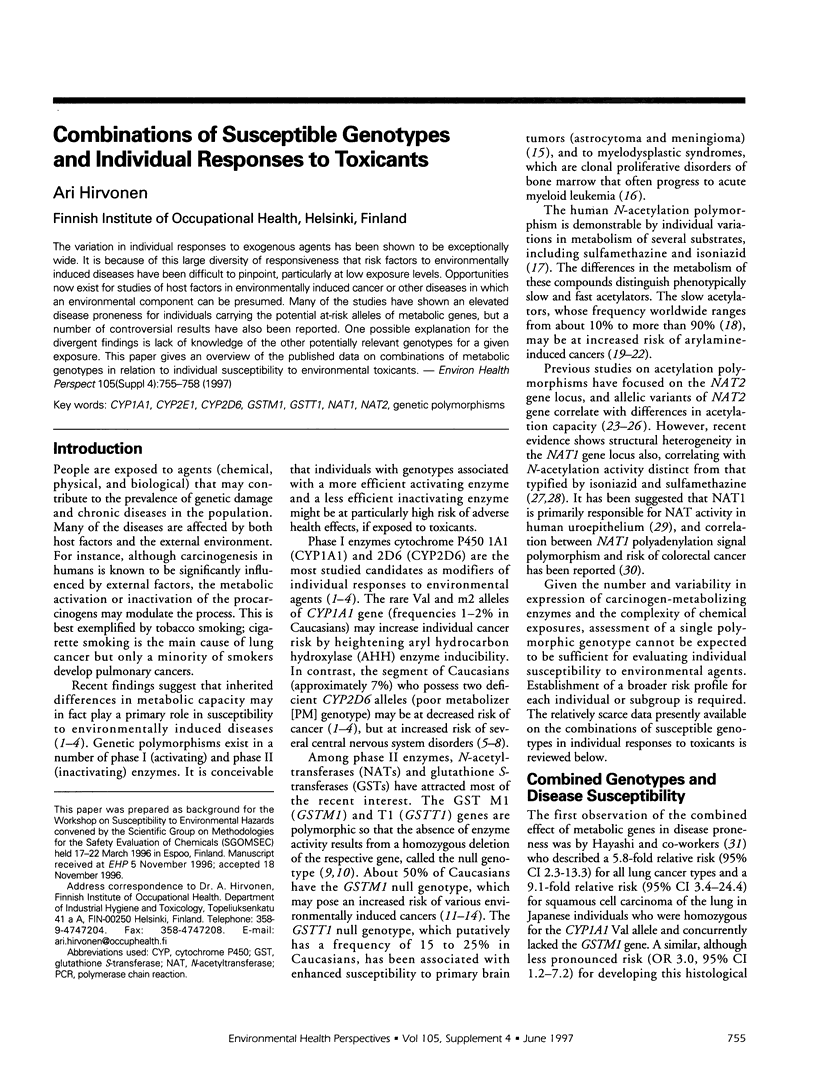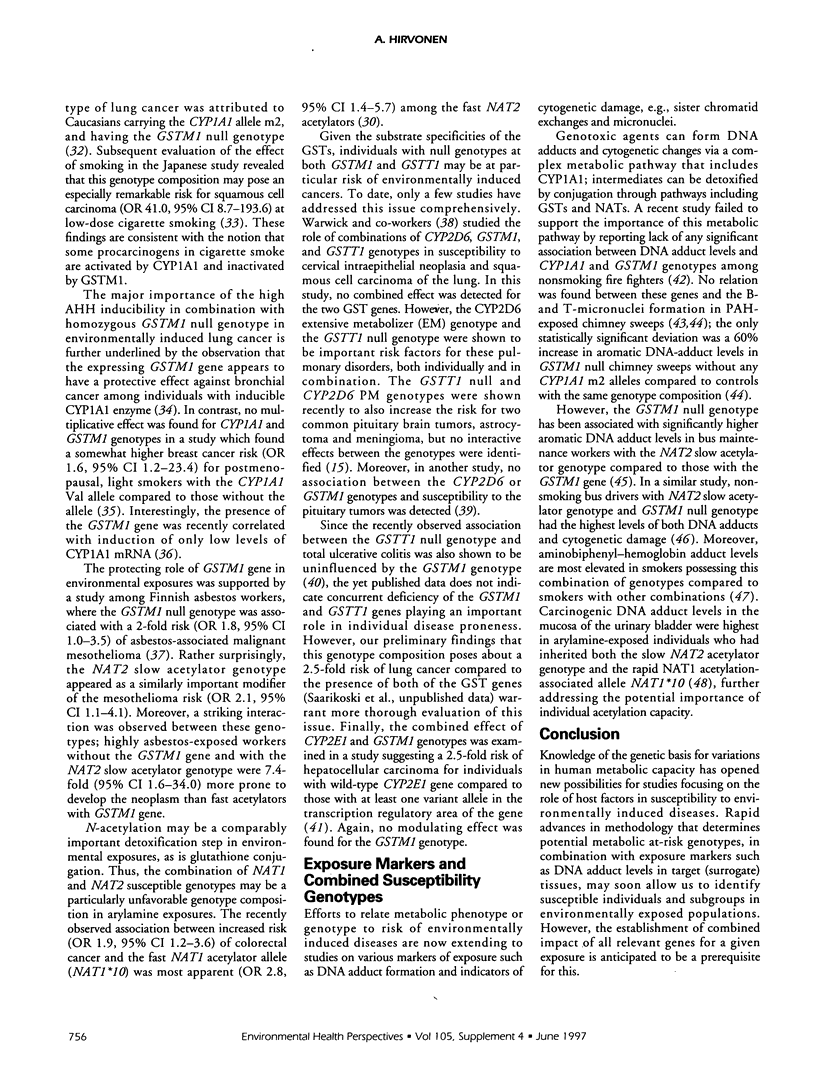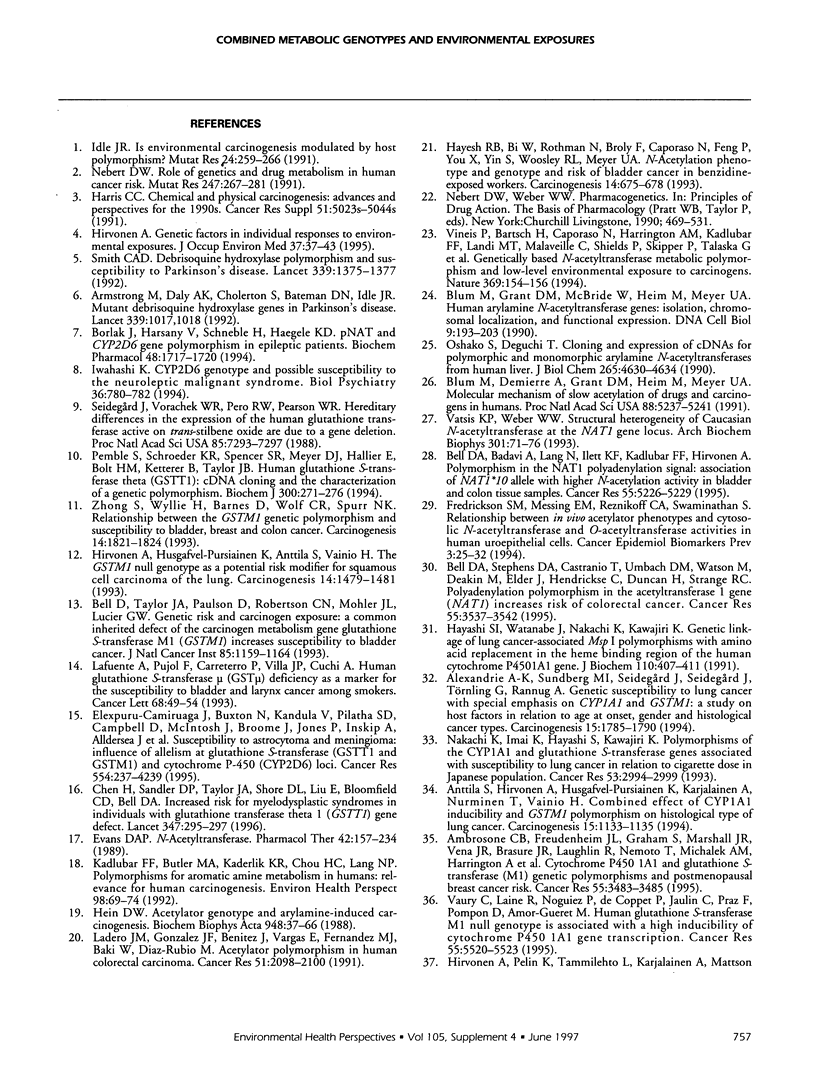Abstract
The variation in individual responses to exogenous agents has been shown to be exceptionally wide. It is because of this large diversity of responsiveness that risk factors to environmentally induced diseases have been difficult to pinpoint, particularly at low exposure levels. Opportunities now exist for studies of host factors in environmentally induced cancer or other diseases in which an environmental component can be presumed. Many of the studies have shown an elevated disease proneness for individuals carrying the potential at-risk alleles of metabolic genes, but a number of controversial results have also been reported. One possible explanation for the divergent findings is lack of knowledge of the other potentially relevant genotypes for a given exposure. This paper gives an overview of the published data on combinations of metabolic genotypes in relation to individual susceptibility to environmental toxicants.
Full text
PDF



Selected References
These references are in PubMed. This may not be the complete list of references from this article.
- Alexandrie A. K., Sundberg M. I., Seidegård J., Tornling G., Rannug A. Genetic susceptibility to lung cancer with special emphasis on CYP1A1 and GSTM1: a study on host factors in relation to age at onset, gender and histological cancer types. Carcinogenesis. 1994 Sep;15(9):1785–1790. doi: 10.1093/carcin/15.9.1785. [DOI] [PubMed] [Google Scholar]
- Ambrosone C. B., Freudenheim J. L., Graham S., Marshall J. R., Vena J. E., Brasure J. R., Laughlin R., Nemoto T., Michalek A. M., Harrington A. Cytochrome P4501A1 and glutathione S-transferase (M1) genetic polymorphisms and postmenopausal breast cancer risk. Cancer Res. 1995 Aug 15;55(16):3483–3485. [PubMed] [Google Scholar]
- Anttila S., Hirvonen A., Husgafvel-Pursiainen K., Karjalainen A., Nurminen T., Vainio H. Combined effect of CYP1A1 inducibility and GSTM1 polymorphism on histological type of lung cancer. Carcinogenesis. 1994 Jun;15(6):1133–1135. doi: 10.1093/carcin/15.6.1133. [DOI] [PubMed] [Google Scholar]
- Armstrong M., Daly A. K., Cholerton S., Bateman D. N., Idle J. R. Mutant debrisoquine hydroxylation genes in Parkinson's disease. Lancet. 1992 Apr 25;339(8800):1017–1018. doi: 10.1016/0140-6736(92)90537-d. [DOI] [PubMed] [Google Scholar]
- Badawi A. F., Hirvonen A., Bell D. A., Lang N. P., Kadlubar F. F. Role of aromatic amine acetyltransferases, NAT1 and NAT2, in carcinogen-DNA adduct formation in the human urinary bladder. Cancer Res. 1995 Nov 15;55(22):5230–5237. [PubMed] [Google Scholar]
- Bell D. A., Badawi A. F., Lang N. P., Ilett K. F., Kadlubar F. F., Hirvonen A. Polymorphism in the N-acetyltransferase 1 (NAT1) polyadenylation signal: association of NAT1*10 allele with higher N-acetylation activity in bladder and colon tissue. Cancer Res. 1995 Nov 15;55(22):5226–5229. [PubMed] [Google Scholar]
- Bell D. A., Stephens E. A., Castranio T., Umbach D. M., Watson M., Deakin M., Elder J., Hendrickse C., Duncan H., Strange R. C. Polyadenylation polymorphism in the acetyltransferase 1 gene (NAT1) increases risk of colorectal cancer. Cancer Res. 1995 Aug 15;55(16):3537–3542. [PubMed] [Google Scholar]
- Bell D. A., Taylor J. A., Paulson D. F., Robertson C. N., Mohler J. L., Lucier G. W. Genetic risk and carcinogen exposure: a common inherited defect of the carcinogen-metabolism gene glutathione S-transferase M1 (GSTM1) that increases susceptibility to bladder cancer. J Natl Cancer Inst. 1993 Jul 21;85(14):1159–1164. doi: 10.1093/jnci/85.14.1159. [DOI] [PubMed] [Google Scholar]
- Blum M., Demierre A., Grant D. M., Heim M., Meyer U. A. Molecular mechanism of slow acetylation of drugs and carcinogens in humans. Proc Natl Acad Sci U S A. 1991 Jun 15;88(12):5237–5241. doi: 10.1073/pnas.88.12.5237. [DOI] [PMC free article] [PubMed] [Google Scholar]
- Blum M., Grant D. M., McBride W., Heim M., Meyer U. A. Human arylamine N-acetyltransferase genes: isolation, chromosomal localization, and functional expression. DNA Cell Biol. 1990 Apr;9(3):193–203. doi: 10.1089/dna.1990.9.193. [DOI] [PubMed] [Google Scholar]
- Borlak J. T., Harsany V., Schneble H., Haegele K. D. pNAT and CYP2D6 gene polymorphism in epileptic patients. Biochem Pharmacol. 1994 Nov 1;48(9):1717–1720. doi: 10.1016/0006-2952(94)90456-1. [DOI] [PubMed] [Google Scholar]
- Carstensen U., Alexandrie A. K., Högstedt B., Rannug A., Bratt I., Hagmar L. B- and T-lymphocyte micronuclei in chimney sweeps with respect to genetic polymorphism for CYP1A1 and GST1 (class Mu). Mutat Res. 1993 Oct;289(2):187–195. doi: 10.1016/0027-5107(93)90069-r. [DOI] [PubMed] [Google Scholar]
- Chen H., Sandler D. P., Taylor J. A., Shore D. L., Liu E., Bloomfield C. D., Bell D. A. Increased risk for myelodysplastic syndromes in individuals with glutathione transferase theta 1 (GSTT1) gene defect. Lancet. 1996 Feb 3;347(8997):295–297. doi: 10.1016/s0140-6736(96)90468-7. [DOI] [PubMed] [Google Scholar]
- Duncan H., Swan C., Green J., Jones P., Brannigan K., Alldersea J., Fryer A. A., Strange R. C. Susceptibility to ulcerative colitis and Crohn's disease: interactions between glutathione S-transferase GSTM1 and GSTT1 genotypes. Clin Chim Acta. 1995 Aug 31;240(1):53–61. doi: 10.1016/0009-8981(95)06127-4. [DOI] [PubMed] [Google Scholar]
- Elexpuru-Camiruaga J., Buxton N., Kandula V., Dias P. S., Campbell D., McIntosh J., Broome J., Jones P., Inskip A., Alldersea J. Susceptibility to astrocytoma and meningioma: influence of allelism at glutathione S-transferase (GSTT1 and GSTM1) and cytochrome P-450 (CYP2D6) loci. Cancer Res. 1995 Oct 1;55(19):4237–4239. [PubMed] [Google Scholar]
- Evans D. A. N-acetyltransferase. Pharmacol Ther. 1989;42(2):157–234. doi: 10.1016/0163-7258(89)90036-3. [DOI] [PubMed] [Google Scholar]
- Frederickson S. M., Messing E. M., Reznikoff C. A., Swaminathan S. Relationship between in vivo acetylator phenotypes and cytosolic N-acetyltransferase and O-acetyltransferase activities in human uroepithelial cells. Cancer Epidemiol Biomarkers Prev. 1994 Jan-Feb;3(1):25–32. [PubMed] [Google Scholar]
- Harris C. C. Chemical and physical carcinogenesis: advances and perspectives for the 1990s. Cancer Res. 1991 Sep 15;51(18 Suppl):5023s–5044s. [PubMed] [Google Scholar]
- Hayashi S., Watanabe J., Nakachi K., Kawajiri K. Genetic linkage of lung cancer-associated MspI polymorphisms with amino acid replacement in the heme binding region of the human cytochrome P450IA1 gene. J Biochem. 1991 Sep;110(3):407–411. doi: 10.1093/oxfordjournals.jbchem.a123594. [DOI] [PubMed] [Google Scholar]
- Hayes R. B., Bi W., Rothman N., Broly F., Caporaso N., Feng P., You X., Yin S., Woosley R. L., Meyer U. A. N-acetylation phenotype and genotype and risk of bladder cancer in benzidine-exposed workers. Carcinogenesis. 1993 Apr;14(4):675–678. doi: 10.1093/carcin/14.4.675. [DOI] [PubMed] [Google Scholar]
- Hein D. W. Acetylator genotype and arylamine-induced carcinogenesis. Biochim Biophys Acta. 1988 Aug 3;948(1):37–66. doi: 10.1016/0304-419x(88)90004-2. [DOI] [PubMed] [Google Scholar]
- Hirvonen A. Genetic factors in individual responses to environmental exposures. J Occup Environ Med. 1995 Jan;37(1):37–43. doi: 10.1097/00043764-199501000-00006. [DOI] [PubMed] [Google Scholar]
- Hirvonen A., Husgafvel-Pursiainen K., Anttila S., Vainio H. The GSTM1 null genotype as a potential risk modifier for squamous cell carcinoma of the lung. Carcinogenesis. 1993 Jul;14(7):1479–1481. doi: 10.1093/carcin/14.7.1479. [DOI] [PubMed] [Google Scholar]
- Hirvonen A., Pelin K., Tammilehto L., Karjalainen A., Mattson K., Linnainmaa K. Inherited GSTM1 and NAT2 defects as concurrent risk modifiers in asbestos-related human malignant mesothelioma. Cancer Res. 1995 Jul 15;55(14):2981–2983. [PubMed] [Google Scholar]
- Hou S. M., Lambert B., Hemminki K. Relationship between hprt mutant frequency, aromatic DNA adducts and genotypes for GSTM1 and NAT2 in bus maintenance workers. Carcinogenesis. 1995 Aug;16(8):1913–1917. doi: 10.1093/carcin/16.8.1913. [DOI] [PubMed] [Google Scholar]
- Ichiba M., Hagmar L., Rannug A., Högstedt B., Alexandrie A. K., Carstensen U., Hemminki K. Aromatic DNA adducts, micronuclei and genetic polymorphism for CYP1A1 and GST1 in chimney sweeps. Carcinogenesis. 1994 Jul;15(7):1347–1352. doi: 10.1093/carcin/15.7.1347. [DOI] [PubMed] [Google Scholar]
- Idle J. R. Is environmental carcinogenesis modulated by host polymorphism? Mutat Res. 1991 Apr;247(2):259–266. doi: 10.1016/0027-5107(91)90021-f. [DOI] [PubMed] [Google Scholar]
- Iwahashi K. CYP2D6 genotype and possible susceptibility to the neuroleptic malignant syndrome. Biol Psychiatry. 1994 Dec 1;36(11):781–782. doi: 10.1016/0006-3223(94)90094-9. [DOI] [PubMed] [Google Scholar]
- Kadlubar F. F., Butler M. A., Kaderlik K. R., Chou H. C., Lang N. P. Polymorphisms for aromatic amine metabolism in humans: relevance for human carcinogenesis. Environ Health Perspect. 1992 Nov;98:69–74. doi: 10.1289/ehp.929869. [DOI] [PMC free article] [PubMed] [Google Scholar]
- Ladero J. M., González J. F., Benítez J., Vargas E., Fernández M. J., Baki W., Diaz-Rubio M. Acetylator polymorphism in human colorectal carcinoma. Cancer Res. 1991 Apr 15;51(8):2098–2100. [PubMed] [Google Scholar]
- Lafuente A., Pujol F., Carretero P., Villa J. P., Cuchi A. Human glutathione S-transferase mu (GST mu) deficiency as a marker for the susceptibility to bladder and larynx cancer among smokers. Cancer Lett. 1993 Jan 15;68(1):49–54. doi: 10.1016/0304-3835(93)90218-x. [DOI] [PubMed] [Google Scholar]
- Nakachi K., Imai K., Hayashi S., Kawajiri K. Polymorphisms of the CYP1A1 and glutathione S-transferase genes associated with susceptibility to lung cancer in relation to cigarette dose in a Japanese population. Cancer Res. 1993 Jul 1;53(13):2994–2999. [PubMed] [Google Scholar]
- Nebert D. W. Role of genetics and drug metabolism in human cancer risk. Mutat Res. 1991 Apr;247(2):267–281. doi: 10.1016/0027-5107(91)90022-g. [DOI] [PubMed] [Google Scholar]
- Ohsako S., Deguchi T. Cloning and expression of cDNAs for polymorphic and monomorphic arylamine N-acetyltransferases from human liver. J Biol Chem. 1990 Mar 15;265(8):4630–4634. [PubMed] [Google Scholar]
- Pemble S., Schroeder K. R., Spencer S. R., Meyer D. J., Hallier E., Bolt H. M., Ketterer B., Taylor J. B. Human glutathione S-transferase theta (GSTT1): cDNA cloning and the characterization of a genetic polymorphism. Biochem J. 1994 May 15;300(Pt 1):271–276. doi: 10.1042/bj3000271. [DOI] [PMC free article] [PubMed] [Google Scholar]
- Perrett C. W., Clayton R. N., Pistorello M., Boscaro M., Scanarini M., Bates A. S., Buckley N., Jones P., Fryer A. A., Gilford J. GSTM1 and CYP2D6 genotype frequencies in patients with pituitary tumours: effects on P53, ras and gsp. Carcinogenesis. 1995 Jul;16(7):1643–1645. doi: 10.1093/carcin/16.7.1643. [DOI] [PubMed] [Google Scholar]
- Rothman N., Shields P. G., Poirier M. C., Harrington A. M., Ford D. P., Strickland P. T. The impact of glutathione s-transferase M1 and cytochrome P450 1A1 genotypes on white-blood-cell polycyclic aromatic hydrocarbon-DNA adduct levels in humans. Mol Carcinog. 1995 Sep;14(1):63–68. doi: 10.1002/mc.2940140111. [DOI] [PubMed] [Google Scholar]
- Seidegård J., Vorachek W. R., Pero R. W., Pearson W. R. Hereditary differences in the expression of the human glutathione transferase active on trans-stilbene oxide are due to a gene deletion. Proc Natl Acad Sci U S A. 1988 Oct;85(19):7293–7297. doi: 10.1073/pnas.85.19.7293. [DOI] [PMC free article] [PubMed] [Google Scholar]
- Smith C. A., Gough A. C., Leigh P. N., Summers B. A., Harding A. E., Maraganore D. M., Sturman S. G., Schapira A. H., Williams A. C., Maranganore D. M. Debrisoquine hydroxylase gene polymorphism and susceptibility to Parkinson's disease. Lancet. 1992 Jun 6;339(8806):1375–1377. doi: 10.1016/0140-6736(92)91196-f. [DOI] [PubMed] [Google Scholar]
- Vatsis K. P., Weber W. W. Structural heterogeneity of Caucasian N-acetyltransferase at the NAT1 gene locus. Arch Biochem Biophys. 1993 Feb 15;301(1):71–76. doi: 10.1006/abbi.1993.1116. [DOI] [PubMed] [Google Scholar]
- Vaury C., Lainé R., Noguiez P., de Coppet P., Jaulin C., Praz F., Pompon D., Amor-Guéret M. Human glutathione S-transferase M1 null genotype is associated with a high inducibility of cytochrome P450 1A1 gene transcription. Cancer Res. 1995 Dec 1;55(23):5520–5523. [PubMed] [Google Scholar]
- Vineis P., Bartsch H., Caporaso N., Harrington A. M., Kadlubar F. F., Landi M. T., Malaveille C., Shields P. G., Skipper P., Talaska G. Genetically based N-acetyltransferase metabolic polymorphism and low-level environmental exposure to carcinogens. Nature. 1994 May 12;369(6476):154–156. doi: 10.1038/369154a0. [DOI] [PubMed] [Google Scholar]
- Warwick A., Sarhanis P., Redman C., Pemble S., Taylor J. B., Ketterer B., Jones P., Alldersea J., Gilford J., Yengi L. Theta class glutathione S-transferase GSTT1 genotypes and susceptibility to cervical neoplasia: interactions with GSTM1, CYP2D6 and smoking. Carcinogenesis. 1994 Dec;15(12):2841–2845. doi: 10.1093/carcin/15.12.2841. [DOI] [PubMed] [Google Scholar]
- Yu M. C., Ross R. K., Chan K. K., Henderson B. E., Skipper P. L., Tannenbaum S. R., Coetzee G. A. Glutathione S-transferase M1 genotype affects aminobiphenyl-hemoglobin adduct levels in white, black and Asian smokers and nonsmokers. Cancer Epidemiol Biomarkers Prev. 1995 Dec;4(8):861–864. [PubMed] [Google Scholar]
- Yu M. W., Gladek-Yarborough A., Chiamprasert S., Santella R. M., Liaw Y. F., Chen C. J. Cytochrome P450 2E1 and glutathione S-transferase M1 polymorphisms and susceptibility to hepatocellular carcinoma. Gastroenterology. 1995 Oct;109(4):1266–1273. doi: 10.1016/0016-5085(95)90587-1. [DOI] [PubMed] [Google Scholar]
- Zhong S., Wyllie A. H., Barnes D., Wolf C. R., Spurr N. K. Relationship between the GSTM1 genetic polymorphism and susceptibility to bladder, breast and colon cancer. Carcinogenesis. 1993 Sep;14(9):1821–1824. doi: 10.1093/carcin/14.9.1821. [DOI] [PubMed] [Google Scholar]


